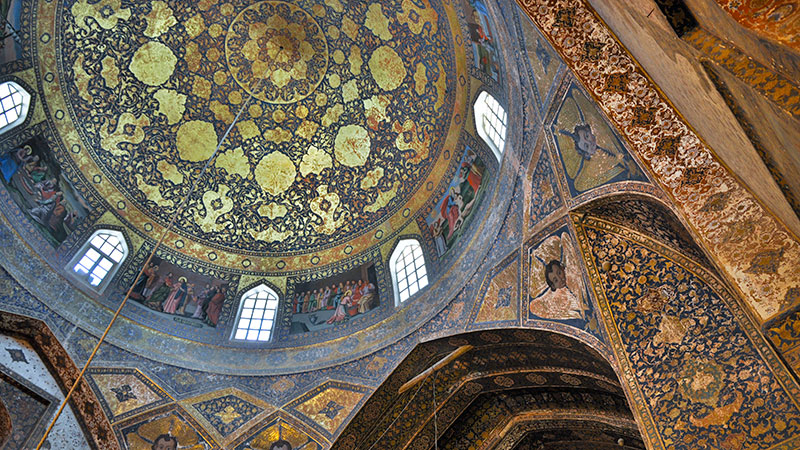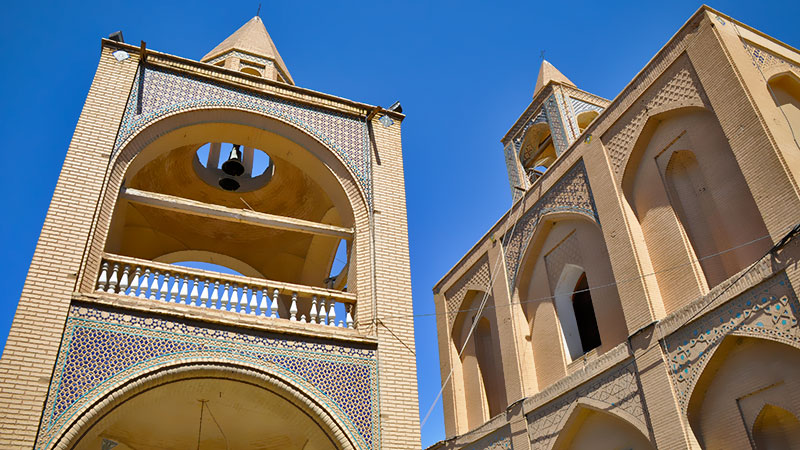 Signin with Google
Signin with Google Signin with Facebook
Signin with Facebook
 Places,Culture
Places,CultureVank Cathedral, the Armenian Heritage in Half of the World

Islamic glory Vs. Christian beauty
Wandering around the Islamic capital of Persian arts and architecture, among the magnificent mosques, the ironic Vank Cathedral in the New Jolfa district has been the glory of Isfahan since the 17th century until now. If the Islamic architecture of the Safavids is distinguished fairly, then the masterpiece of Armenian Christian artists in the New Jolfa district is the junction point of the religious arts.
A New Jolfa in Isfahan
The initial church has roots in the time of the wars between the Ottoman Empire, and Safavids which caused vamoosing of 3000 Armenians to Iran forcibly. Shah Abbas the Great resettled them all in his new capital, Isfahan, on the southern bank of Zayandeh River.
They named the district New Jolfa, in memory of the part from which they had come. New Jolfa is linked to the Muslim part of the town, by an ancient masterpiece bridge on the Zayandeh River, named Sio-Se-pol.
Armenians built a church in New Jolfa named Surp Amena prigich Vank (also known as The Church of the Saintly Sisters) meaning everyone’s holy saviour; the construction of the first built church dates back to the 1606 AC. Then Isfahan sought economic flourishing and boom and witnessed the joy of Christians for religious liberty. Moreover, a sizable number of Armenians from Armenia and Azarbaijan immigrated to Iran and mostly Isfahan.

With the growth of the Armenian population, the church was not spacious enough for ceremonies. Subsequently, the old church was destructed, and the new church was built with considerable alterations and absolute perfectionism in nine years.
The new cathedral was the first monument built with the vast mural designs of fine paintings and gilded carvings, mixing the west and Iranian Islamic arts in one place. The incorporation of Islamic Safavid and Armenian architectural elements has made the unique Cathedral among others in that era.
The New Layout
Now everyone knows the cathedral with the name Vank. It has different parts other than the main church building as chapel and nave. Next to the cathedral, underneath the two-storey belfry, the graves of Orthodox and Protestant Christians locate. Right next to the belfry is the collections of stones from ruins of the old churches of Jolfa quarters and there is a memorial monument in memory of those who lost their lives during the Ottoman massacre. And finally, a 100-year- old museum across the courtyard, facing the cathedral alongside a library with more than 10.000 priceless books.
The main building Is the first structure with the utmost usage of paintings applying oil painting and glided carving techniques. Persian elements such as frieze tiles, stucco decoration, represent everywhere in the interior hall accompanying the oil paintings shows the story of human creation to the crucifixion of Christ from the Old and New Testament.

Flair of Genius
This cathedral is a perfect example of versatility with surroundings, culture and the new environment in terms of art and architecture. They replaced tradition with their needs with new materials. For example, instead of using stones in constructing the church, like all other Armenian build churches, it was built using bricks which were more accessible at the time. Likewise, the dome of the church has two layers that represent an interpretation of Persian architecture. Moreover, the interior design of the church is a perfect example of Armenian architecture, whereas the exterior is a genius combination of both Persian and Armenian styles.
Even though the abundant use of ornaments was widespread in Persian architecture at the time, most of the outer walls were simple and modest. It assumes that this simplicity might be a smart action to avoid any kind of resentment from the Muslim community and/or at the same time, reflection on the introversive beliefs in the Persian culture.

The first printing machine in the Middle East
The two-storey building of the museum in the corner of the yard displays numerous artefacts and collections from the history of the cathedral. The library also contains a valuable archive of extraordinary manuscripts. The oldest and the most interesting of all the manuscripts is a bible from the 10th century. It is remarkable to know the Armenian community developed the first printing press and the first printed book in Iran. This printed book is now being held in Oxford, United Kingdom.

Today the Armenians of the New Jolfa welcome all Iranians and tourists to their peaceful Jolfa with a vibrant atmosphere and cosy cafes and restaurants. Take the vantage of feeling Armenian culture in the heart of the Iranian cradle of art and culture in Isfahan.
By Maryam Mobarhani / TasteIran

